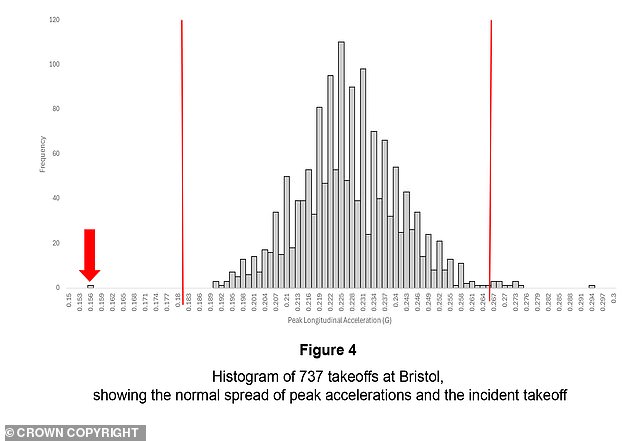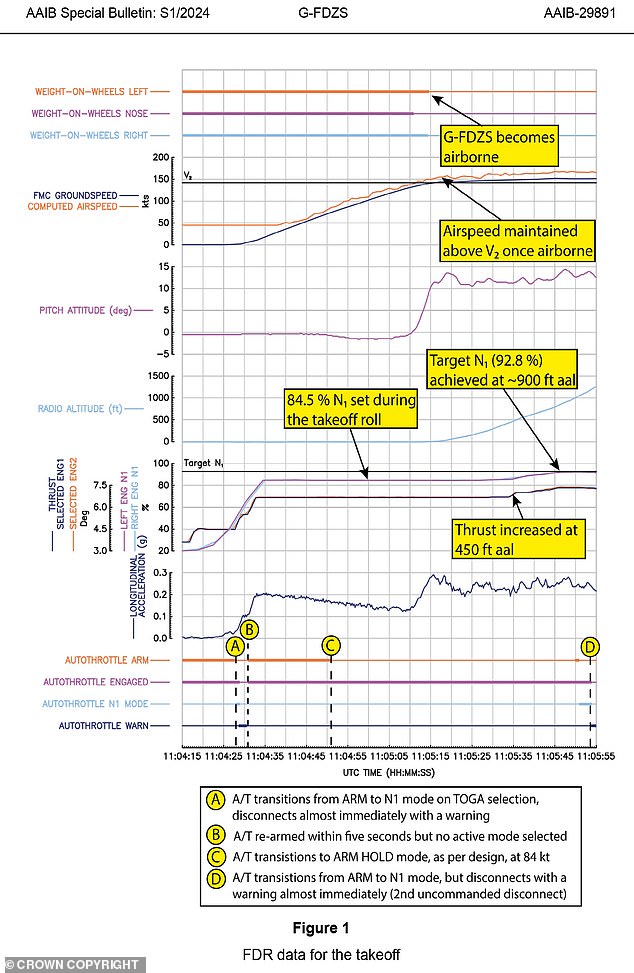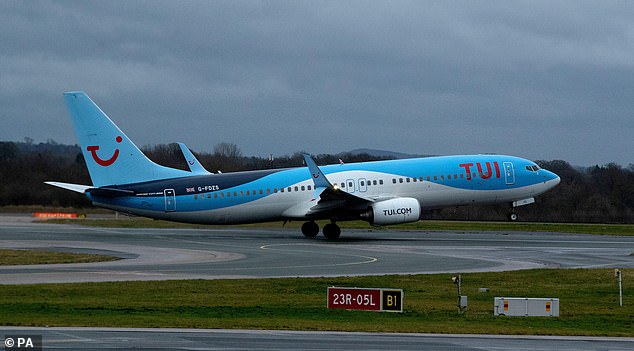A passenger plane carrying 163 passengers and nine crew missed the end of a runway by just three meters after a software glitch allowed it to take off using very little power.
The TUI Boeing 737-800 was taking off from Bristol Airport’s 1.2-mile runway 9 towards Gran Canaria on March 4 when it had trouble taking off.
The 15-year-old plane took off with just 260 meters (853 feet) of runway left, clearing the end of the runway at a height of just 10 feet. It then passed over the nearby A38 road less than 30 meters away.
When the plane’s wheels finally left the ground, it was traveling at about 150 knots, meaning it would have skidded off the runway less than three seconds later.
The Department of Transportation’s Air Accident Investigation Branch is investigating the incident, which it describes as “serious.” They have issued a special warning to airlines using the next-generation Boeing 737-800 series over the software issue that jeopardized flight safety.
The report says Boeing was aware of the software glitch before the incident that caused the plane to have difficulty taking off.
According to the AAIB report: “A Boeing 737-800 completed a take-off from runway 09 at Bristol Airport with insufficient thrust to meet regulated performance.”
Aviation experts recognize that planes that take off with insufficient thrust risk stalling and crashing to the ground.
The Tui Boeing 737-800, pictured, only passed the end of the runway at a height of 10 feet and passed over the A38 at less than 100 feet as it rose heavily into the air due to a software glitch that selected a “insufficient thrust” setting.

The plane’s flight management computer recorded 11 failures in the plane’s autothrottle system.

The Air Accident Investigation Division’s preliminary investigation found that the aircraft’s acceleration performance was significantly worse than other aircraft. The two red lines in the graph show the average performance of 99.7 percent of other B737s at Bristol Airport.
The report states that the aircraft’s automatic throttle system was disabled when the crew selected takeoff mode. Instead of the 92.8 percent thrust needed to take off safely, the plane lumbered down the runway using only 84.5 percent.
Neither pilot noticed the potentially fatal lack of power needed to take off safely.
A review of the problems on the affected flight showed 11 errors, many of them related to the aircraft’s autothrottle system.
The data showed that the system, designed to reduce the workload of the flight crew, disconnected twice during the flight.
Performance data collected by the AAIB comparing the flight with other takeoffs from Bristol Airport showed that its acceleration was significantly slower than that of 99.7 per cent of other aircraft of the same model departing from the same airport.
According to the AAIB, the autothrottle system on a Boeing 737-800 can control thrust from takeoff to landing.
Investigators asked Boeing about its autothrottle system and admitted they were aware of a “long history of nuisance disconnections during takeoff modes.”

The AAIB was able to download the plane’s flight data recorder black box that showed the plane’s poor performance during takeoff.
However, when these disconnections are investigated, “subsequent system functionality checks typically do not find faults.”
Boeing said earlier versions of the system can disengage when the flight crew presses a button during their normal takeoff procedure.
According to the AAIB report: ‘The manufacturer recommends that any 737NG operator affected by these disconnections retrofit their aircraft with the newest model of ASM (auto-throttle servo motor) and associated flight control computer software.
The AAIB report said the plane’s cockpit voice recorder only recorded the last two hours of the flight, so what the two pilots said was deleted and overwritten when they arrived at Las Palmas airport.
However, investigators were able to recover the flight data recorder, the Black Box, which provided them with vital data on the aircraft’s performance.
This incident is the latest in a series of worrying safety problems that have plagued Boeing aircraft over the past decade.
Federal prosecutors are considering prosecuting the manufacturer over allegations that violated an agreement that allowed the company to avoid criminal prosecution after two fatal crashes involving its 737 Max aircraft more than five years ago.
Last month, the US Department of Justice informed a federal judge about the possible breach.
It is now up to the Department of Justice (DOJ) to decide whether to file charges against Boeing. Prosecutors will inform the court no later than today how they plan to proceed, the department said.
The new 737 Max planes crashed in 2018 in Indonesia and in 2019 in Ethiopia, killing 346 people. Boeing reached a £1.97 billion settlement with the Department of Justice in January 2021 to avoid being prosecuted on a single count of fraud: misleading federal regulators who approved the plane. Boeing blamed the deception on two relatively low-level employees.
In a letter filed last month in federal court in Texas, Glenn Leon, chief of the fraud section of the Justice Department’s criminal division, said Boeing violated the terms of the agreement by failing to make promised changes to detect and prevent violations of federal anti-fraud laws. .
The determination means Boeing could be prosecuted “for any federal criminal violation of which the United States is aware,” including the fraud charge the company hoped to avoid with the deal, the Justice Department said.
However, it is unclear whether the government will prosecute Boeing.
“The Government is determining how it will proceed in this matter,” the Justice Department said in the court filing.
Boeing will have until June 13 to respond to the government’s allegation, and the department said it will consider the company’s explanation “to determine whether a judicial process should be initiated.”
Boeing Co, based in Arlington, Virginia, disputed the Justice Department’s conclusion.
“We believe we have met the terms of that agreement and look forward to having the opportunity to respond to the Department on this matter,” a Boeing spokesperson said in a statement.
“In doing so, we will engage with the Department with the utmost transparency, as we have done throughout the life of the agreement, including in response to its questions following the Alaska Airlines 1282 crash.”
Boeing has been under renewed scrutiny since that Alaska Airlines flight in January, when a door plug on a 737 Max exploded, leaving a gaping hole in the side of the plane.
The company is under multiple investigations into the explosion and its manufacturing quality. The FBI has told passengers on the flight that they could be victims of a crime.
Prosecutors said they will meet on May 31 with the families of the passengers who died in the two Max crashes. Relatives were angry and disappointed after a similar meeting last month.
Paul Cassell, an attorney representing the families of passengers in the second crash, said the Justice Department’s determination that Boeing violated the terms of the settlement is “a positive first step, and for the families, a long road ahead.” travel”.
Investigations into the crashes pointed to a flight control system that Boeing added to the Max without notifying pilots or airlines. Boeing downplayed the importance of the system and did not review it until after the second accident.
After secret negotiations, the government agreed not to prosecute Boeing for defrauding the United States by misleading regulators about the flight system.
The settlement included a £192.4 million fine, a £395 million fund for compensation to victims and almost £1.4 billion for airlines whose Max planes were grounded for almost two years.
Boeing has faced civil lawsuits, congressional investigations and massive damage to its business since the crashes in Indonesia and Ethiopia.
The manufacturer’s outgoing CEO, Dave Calhoun, will testify before a US Senate panel later this month to answer questions about safety and production issues at the plane maker.
The June 18 appearance before the Senate Permanent Subcommittee on Investigations follows a hearing in April in which four whistleblowers alleged that there were safety problems in the production of three of the four commercial airplanes currently produced by Boeing: the 737 MAX, the 787 Dreamliner. and the 777.
“I look forward to Mr. Calhoun’s testimony, which is a necessary step to meaningfully address Boeing’s failures, regain public trust, and restore the company’s central role in the American economy and national defense,” said the Democratic Senator Richard Blumenthal, who chairs the subcommittee. .
A TUI spokesperson told MailOnline: “We have worked closely with the authorities to provide all available information. The AAIB’s recommendations and learnings resulting from this take-off will support the entire aviation sector and other airlines.
“The safety of our passengers and crew is always our top priority.”
MailOnline has contacted the Air Accident Investigation Branch (AAIB) and Boeing for comment on this most recent incident.

